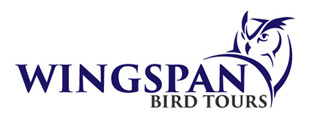Tours
- Overview/list of tour details
- SOMERSET LEVELS
- Colombia - Andean Endemics
- Sri Lanka
- Costa Rica
- Morocco
- Coto Donana and Extremadura
- Lesvos
- Lake Kerkini - N Greece
- Bulgaria
- Eastern Poland
- Extremadura & Sierra de Gredos
- Spanish Pyrenees
- Andalucia - Birds and Butterflies
- Spain - Autumn Migration I
- Isles of Scilly
- Dorset - Autumn Tour
- Gambia
- Day Tours - Spain
- Day Tours UK
GUYANA - TOUR DESCRIPTION AND ITINERARY
LEADERS: BOB BUCKLER, LUKE JOHNSON & Lodge Guides
Little known Guyana sits on the north-eastern shoulder of the vast landmass of South America and has, so far, avoided the attention of mass tourism.
Overshadowed by its huge neighbours Brazil and Argentina this relatively tiny country nestles in alongside Suriname with the Atlantic Ocean providing its eastern boundary. Offering a landmass of some 215,000km² (83,000 square miles) and an English speaking population of just 750,000 Guyana has plenty of space.
Just 5% of the inhabitants live away from the populated developed, coastline thus some 80% of Guyana’s interior is vast areas of untouched rainforest. A magical kingdom of natural habitat with many rivers, mangroves, marshes, savannahs, mountains and pristine tropical rainforest. You will discover this vast wilderness when you join our tour of this rain-forest frontier.
 Up until now Guyana has surrendered up a wealth of wildlife, researchers have so far listed some 225 species of mammals, 810 species of birds, 300 reptiles and amphibians and an enormous total of plants.
Up until now Guyana has surrendered up a wealth of wildlife, researchers have so far listed some 225 species of mammals, 810 species of birds, 300 reptiles and amphibians and an enormous total of plants.
On a typical Wingspan Tour you can expect to discover many of these species for yourself, recent tours uncovered the likes of jaguar, capybara, green anaconda, giant anteater, giant otter, tapir, red-rumped agouti, collared peccary, red howler monkey, black spider monkey, two and three-toed sloth, black & spectacled caiman. Bird-life is prolific with Harpy Eagle, Guianan Cock-of-the-Rock, Blood-coloured Woodpecker, Rufous Crab Hawk, topping a typical list of some 400 species of birds.
Guyana really is the “land of many waters”, you are never far from water, it is a country where wildlife is both prolific and diverse. Jaguar are still numerous, Harpy Eagles nest, Giant Anteaters roam the savannah and Giant River Otters can be seen in the rivers. Add to this a rich forest birdlife which includes spectacular Cotinga species such as Cock of the Rock, Crimson Fruitcrows, also lekking Capuchin birds and Guianan Red Cotingas. Rarer are Rufous-winged Ground-Cuckoos but there are large numbers of Guans, Currasows and Macaws. Accommodation can mostly be termed “rustic”, although largely en-suite, and positioned in fantastic unspoilt bird-rich locations, many are biological research stations.
ITINERARY
The tour starts and ends in the Capital, Georgetown
Day 1
Our trips usually start with a late arrival during the evening of the first night, having travelled all day we quickly transfer to our hotel in the centre of Georgetown. After a light snack its straight to bed for some welcomed rest.
Day 2
A very early start for a trip to the Abary River and a boat trip at Mahaica, on our first guided tour with our local guide. This trip should provide opportunities to see Blood-coloured Woodpecker, Bicoloured Conebill, Rufous Crab Hawk as well as Hoatzin. At the Abary River there is a short, flat trail that leads to coastal mangroves where we will search for the endangered Rufous Crab-hawk and the much sought-after Blood-colored Woodpecker.
Some other coastal species we hope to see are White-bellied and White-barred Piculets Spotted Tody-Flycatcher, Northern Scrub-Flycatcher and Great-billed Seed-finch. Other possibilities here are Long-winged Harrier which is commonly seen along the highway and trails by sugar canes. Other species at Mahaicony River may include Masked Duck and Green & Rufous Kingfisher although we should get other opportunities for the latter. 
Basket-Breakfast and picnic lunch is provided on this trip. On the way to Abary, there should also be an opportunity to call in at Hope Beach for a short stop where there are Scarlet Ibis, migrant shorebirds and tropical terns.
Our afternoon may be spent at the Demerara River and the Garden of Eden. During the afternoon the latter is particularly good for hummingbirds such as Blue-chinned Sapphire, White-chinned Sapphire, Fork-tailed Woodnymph, Green-tailed Goldenthroat, Glittering- throated Emerald. It is also possible to see Azure Gallinule, Little Cuckoo, Gray Kingbird and Wing-barred Seedeater. We return to Georgetown for our evening meal and an early night after a long day in the field.
Day 3-4
We start the day with a trip to the Botanical Gardens which are within easy walking distance of our hotel. We shall have a good chance of Festive Parrot as well as a second chance at seeing White-bellied Piculet and Blood-coloured Woodpecker. Other species possible include Yellow-chinned Spinetail, Black-crested Antshrike, Straight-billed Woodcreeper, White-headed Marsh Tyrant, Gray Kingbird, Black-capped Donacobius and Carib Grackle.
After lunch we will fly to Kaieteur Falls where we start our exciting tour of the interior rain-forest region. At the falls we spend 2 hours birding and enjoying the spectacular views. This is the highest single drop waterfall in the world amidst primary forest in the Pakaraima mountains, part of the Guyanan Shield, with not a guard rail in sight!
A grassy landing strip offers the only means of access to this remote area, we will have the falls to ourselves. There is an interpretive Nature Trail called the Bromeliad Trail where we may see the endemic Golden Rocket Frog which lives and breeds in pockets of water trapped in the Bromeliad leaves.
The trail should offer the first opportunity for Guianan Cock of the Rock although very few individuals are now seen there, also Orange-breasted Falcon which hunts the White-chinned and the rarer White-tipped Swifts both species breed on ledges hidden behind the curtain of water in the falls. We may also find Red-shouldered Tanager and maybe Red and Green Macaws.
From Kaieteur, we fly on for another 50 mins to Iwokrama River Lodge and Research Station where we stay for 2 nights on the banks of the Essequibo river, deep in the Iwokrama reserve.
At Iwokrama, numerous parrots and macaws are found, including Red-fan Parrots, Painted Parakeets and Blue and yellow Macaws. In the early morning on Day 4, we shall travel along the river for half an hour before leaving the boat to climb 900’ up Turtle Mountain both for the spectacular views from the top and the opportunity for some rarer bird species en-route.
This is a primary trail going into forest, it also offers seasonally flooded ‘varzea‘ forest, attracting a variety of speciality birds such as Helmeted Pygmy-tyrant and Tiny Dwarf –Manakin as well as Giant River Otters. Birds found on the trail up the mountain through Terra firma forest are a variety of antbirds and antwrens including Brown-bellied and Rufous-bellied Antwrens, Spotted Antpitta, White-plumed and Rufous-throated Antbirds.
We may also see several species of parrots, Gray-winged Trumpeter, Yellow-billed and Great Jacamars and the near-endemic Red and Black Grosbeak. As the trail climbs, among boulders and vine tangles, Cinereous and Dusky-throated Antshrikes, together with Black-faced and Rufous-capped Antthrushes are a possibility. Golden-sided Euphonia is also found higher up as well as possibly Collared and Spotted Puffbirds. The cliffs below the viewpoint often have Orange-breasted Falcon.
Raptors generally, as well as tanager species are more likely at the top where there are also Chapman’s swifts. For anyone who does not feel able to make this climb – it is only the last part which is a bit steep- there is an option to stay on the river for a trip whilst the rest of the group climb Turtle Mountain.
Birding is also excellent in the grounds of Iwokrama and the easily accessible main dirt road. There are 450-500 species to be found at iwokrama it is an amazing place set in a 1 million acre nature reserve!
Day 5
Together with Luke, our local guide, we transfer by road to our next lodge, Atta. We set off early in the morning so that we can make frequent stops along the bird-rich ‘main’ road. Previous trips have recorded many species but I particularly liked:
Bat Falcon, Black Hawk, Swallow-tailed Kite and Plumbeous Kite, Black Carrasow, Marial Guan and many toucans, toucanets, parrots and parakeets.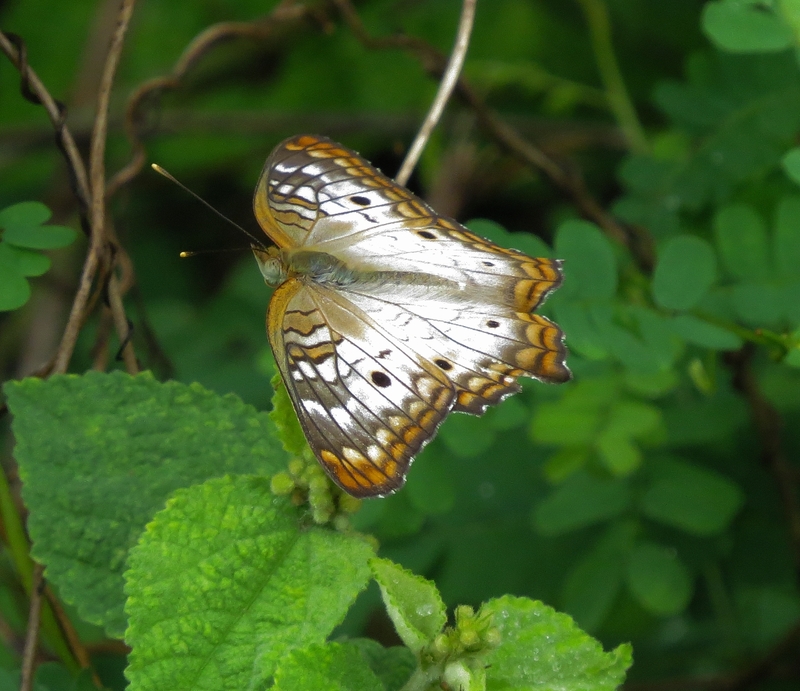
We stop at Mori White-Sand Forest for Black Manakin, Rufous-crowned Elaenia and Red-shouldered Tanager. Rufous-winged Ground-Cuckoo might be seen here too whilst Red-legged Tinamou is another possibility.
Atta lodge is the smallest of the lodges on this trip, nice clean cabins are spaced in an open glade cut from the dense forest. The bird list is just as impressive as the other lodges and there is also the famous Canopy Walkway. The open area around the lodge buildings affords great views of the surrounding trees where White-necked and Pied Puffbirds sit, also where the much sort-after Dusky PurpleTuft and the Crimson Fruit-Crow can be found. After a nice cold drink and home-made cookies we are shown to our cabins where we can prepare ourselves for our visit to famous Atta ‘Canopy Walkway’.
This extensive elevated walkway offers stunning views into the forest canopy where you may find Great Jacamar, Scarlet Macaws, Ruddy Pigeons, Pied Puffbird, Black-spotted Barbet, Honeycreepers and Dacnis. The Black-faced Hawk is an incredibly looking bird and we may be fortunate enough to see one at close quarters thanks to the canopy platforms. Ringed Woodpecker and the Red-necked Woodpecker are often seen along with beautiful Spangled Cotinga. Another speciality of Atta is the White-winged Potoo, the local guide may take us straight to a roosting bird.
DAY 6
Today we spend all day around the Atta Lodge, a morning trip back up to the Canopy Walkway can be very productive but walking the forest trails or scanning along the road can be just as good. It was doing exactly that last year when we found several excellent species and there is always the chance of spotting a Jaguar.
As Atta is located deep in Iwokrama reserve it supports an abundance of species, we may encounter; Guianan Toucanet, Scarlet and Red and Green Macaws, Blue-headed and Dusky Parrots, Waved , Red-necked and Ringed Woodpeckers and lekking Guianan Red Cotinga.
Other species include both Painted and Golden-winged Parakeets, Black Nunbird, Black-spotted Barbet, Mouse-coloured Antshrike, Guianan Warbling Antbird, Todd’s and Spot-tailed Antwrens, Paradise Tanager, Yellow-green Grosbeak, Pompadour Cotinga and Green Oropendula. You need to stay until after dark at the canopy for White-winged Potoo, if we haven’t already seen it, giving itself away with eyeshine in the treetops just after dusk. Variegated Tinamou is a possibility. Both Spix’s and Marail Guans are also found here and careful homework is needed to sort them out.
Blackish Nightjars are a nice local find and mixed flocks of Tanagers may hold the beautiful Turquoise Tanager. Another special find could be a Pompadour Cotinga or even Spangled Cotingas. Walking the forest trails we may bump into a mixed feeding flock of honeycreepers, tanagers, antbirds and woodcreepers or even a Chestnut Woodpecker.
After a long lunch we can take to the tracks back to the main road and bird the whole afternoon in the area where we may see Pied Puffbird, Rose-breasted Chat, and Blue-black Grosbeak, not to mention once again Crimson Topaz! Other possible species on the trails are White-plumed, Spot-winged and Ferruginous-backed Antbirds, Ash-winged and Long-billed Antwrens, as well as McConnell’s and Gray-crowned Flycatchers. 
Black-bellied Cuckoos, Three-toed Sloth and Crimson Fruitcrow may appear at any time.
DAY 7-9
We say goodbye to the lovely staff as we take our leave of Atta, heading towards the Surama Eco Lodge a couple of hours drive from Atta. Surama will have sent their Bedford truck to collect us, we sit some 10 foot off the ground in the back of the truck, it is excellent for birding.
Our plan for this transfer is to make a couple of scheduled stops and plenty of impromptu ones. The first is to visit another Cock-of-the-rock lekking site, this is a much shorter walk through the forest and gives us a second opportunity to see this extraordinary species.
Once back on the truck we make the short journey to the site of the Harpy Eagle nest where a fairly reliable pair have bred for a number of years. Our walk along the forest track to the eagle’s nest will be punctuated by short stops to watch and listen for other species. Antbirds are the order of the day, we may see Rufous-chinned, Scale-backed and the beautiful White-plumed Antbird, what a little stunner that bird is.
 We spend the next 2 hours making our way to Surama being ever vigilant in case a Jaguar crosses the road ahead of us. Roadside pools along the way may produce Rufescent Tiger Heron, Anhinga and Blue and Yellow Macaws may be seen anywhere.
We spend the next 2 hours making our way to Surama being ever vigilant in case a Jaguar crosses the road ahead of us. Roadside pools along the way may produce Rufescent Tiger Heron, Anhinga and Blue and Yellow Macaws may be seen anywhere.
Surama is an Amerindian run Eco lodge with basic facilities and we shall be spending 3 nights here, including a night in a riverside hammock camp beside the Burro Burro River to allow superb early morning wildlife spotting. The walk to the Burro Burro river is across Savannah, about 3km. We shall walk in during the cool of the early evening prior to our night in the hammock camp. The forested part of the track offers “stunning birding” with antbirds, antwrens, Capuchinbird and Golden-headed Manakin. At the end of the track or along the river is the near endemic Guianan Streaked Antwren. It is sometimes seen from the shelter at the end of the “road”. We shall be doing the return walk before the sun’s heat is too great. Facilities at the Carahara landing camp at the river, involve sleeping in a hammock, using a pit toilet and washing in the river. At daybreak from here we shall do a canoe ‘float’ searching for Giant Otter, Tapir, Tira, Spider Monkey and some of the 500 bird species found here including 72 species endemic to the Guianan shield.
The forest is 15 mins walk from the lodge and 500 metres from the lodge is a Golden-headed Manakin lek. It is a great area for wildlife and birds, including the rare Rufous-winged Ground-Cuckoo which can often be seen if you sit waiting quietly. If we manage to see the latter, it will be competing for bird of the trip. So if Surama is an Amerindian run lodge and we shall be spending 3 nights here, including a night in a riverside hammock camp beside the Burro Burro River to allow superb wildlife spotting. (The walk to the Burro Burro river is across Savannah, about 3kms from memory. We shall probably walk in during the cool of the evening prior to our night in camp although it is also described as a “jeep track”. The forested part of the track offers “stunning birding” with antbirds, antwrens, Capuchinbird and Golden-headed Manakin. At the end of the track or along the river is the near endemic Guianan Streaked Antwren. It is sometimes seen from the shelter at the end of the “road”. Hopefully we shall be doing the return walk before the sun’s heat is too great. Facilities at the Carahara landing camp at the river, involve sleeping in a hammock, using a pit toilet and washing in the river. If this does not appeal, staying overnight here is not obligatory, but personally I can’t wait! ) At daybreak from here we shall do a canoe float searching for Giant Otter, Tapir, Tira, Spider Monkey and some of the 500 bird species found here including 72 species endemic to the Guianan shield.
The forest is 15 mins walk from the lodge and 500 metres from the lodge is a Golden-headed Manakin lek. It is a great area for wildlife and birds, including the rare Rufous-winged Ground-Cuckoo which can often be seen if you sit waiting quietly. If we manage to see the latter, it will be competing for bird of the trip. So if we get any opportunities, we shall stop and try very hard for this rare and local bird which may reveal its presence when bill-snapping at ant swarms. Other species found at Surama may include White-chinned Sapphire which feeds on red flowers and Blue-throated Piping Guan. The forest edge holds Fulvous-crested Tanager and Finsch’s Euphonia. If we are lucky enough to find an antswarm, then we may also see White-plumed, Black-chinned and Rufous-throated Antbirds, as well as Long-winged and White-flanked Ant-wrens. It is even possible to see the scarcer Red-billed Woodcreeper here or Crimson Topaz.
Day 10
Our transfer today is to Rockview lodge where we shall spend the next 2 nights. We leave Surama just after an early breakfast and we should arrive around midday just in time for lunch. As we pass through Savannah habitat we may see Southern Lapwing, Double-lined Thick-knee, Fork-tailed Flycatcher, Eastern Meadowlark, Savannah Hawk and many more.
There is a marshy area just north of Rock View which we pass on the way from Surama, it is an excellent place for Cinnamon Attila and Guianan Warbling Antbird. Other birds likely to be seen en route include Aplomado Falcon, Little Chachalaca, Red & Green Macaw, Guianan Puffbird, Green-tailed Jacamar, White-throated Toucan and Great Potoo.
Rockview sits out in the middle of a huge open savannah, it will be a nice relief after spending several days in and around rain-forest. Good birding is available in the grounds and there is also a swimming pool together with excellent accommodation, A fruit basket and juice are included in the rooms and there are also complimentary pre-dinner drinks!
An afternoon guided walk may provide us with sighting of Orange-backed Troupial, Spotted Tody Flycatcher, Yellow-rumped Cacique,Yellow Oriole, Vermillion Flycatcher, White-headed Marsh-Tyrant with Scissor-tailed Flycatchers lining the fences.
Out in the grass meadow we could see Plumbeous Seedeater, Grassland Sparrow, Burnished-buff Tanager and hunting Aplomado Falcons. In the evening a selection of nightjars and nighthawks quarter the fields including Nacunda Nighthawk and White-tailed Nightjar.
DAY 11
We have a full day in the field on our second day at Rockview, there is a short trail up a nearby hill to a very dry vine-filled forest where Southern White-fringed Antwren, White-bellied Antbird, Pale-eyed Pygmy-tyrant, Blue-backed Manakin, Rufous-browed Peppershrike, and Sooty-capped Hermit may all be found. The steep Panorama Trail has woodland birds which include Green-tailed Jacamar, Ochre-bellied and Variegated Flycatcher.
Buff-necked Ibis are in the grounds and there are a number of feeders, including hummingbird feeders attracting Blue-chinned Sapphire, Blue-tailed Emerald and White-tailed Goldenthroat.
DAY 12-13
Our final 2 nights in the interior will be at Karanambu lodge, made famous by Diana McTurk whose home it has been for many years. Now managed by Andrea and Salvador, Diana plays a less active roll, but is usually present. She is a gracious hostess, still passionate about her Giant Otters. Orphan otters can still be seen around the place, together with a tame raccoon. Karanambu is a very unique place, this lodge has something really special, almost sacred, it is a combination of location, the hosts and staff and their close affinity to wildlife.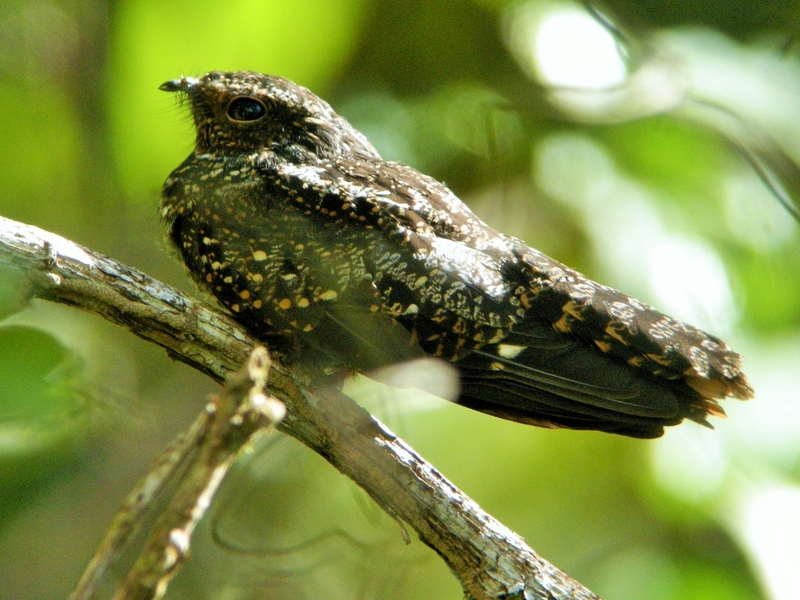
To get to Karanambu we must drive to Ginep Landing where we board a boat. We shall bird along the way and hope to see along this route Toco Toucan, Jabiru, Pinnated Bittern, Cream-coloured Woodpecker, Yellowish Pipit, Wedge-tailed Grassfinch, Moriche Oriole, Orange-backed Troupial or Red-breasted Blackbird. Spotted Puffbird is also sometimes seen.
At Ginep landing we shall transfer to the boats (only if the river is high enough) for a wonderful scenic and bird-filled 2 hours or more along the Rupunini River to Karanambu lodge.
We should manage to see a number of Heron species en route – Capped and Cocoi Herons, plus Fasciated Tiger-heron and if anything else looks promising, we’ll stop to check it out. We shall detour into pools and lagoons to maximize the birdwatching. We should see Jabiru and the vulnerable Agami Heron in low lying wet areas.
The Capuchinbird sometimes flies over the river and Sungrebe are fairly common whilst we should also see Pied Plover, Large-billed Tern, Black Skimmer and Swallow-wing the latter often perched high and conspicuously in tall trees, surprisingly Swallow-wing nest on the ground!
Later into the trip we shall pull into a large pool where the huge Amazon Water Lilies cover the water’s surface, you can see the bulbous flower heads that only open as it gets dark. Spending some quality time just sitting in the middle of a pool we may see Grey-necked Wood Rail, Green Ibis, Brown-collared Hawk and Sunbitterns, it is truly a wonderful experience.
Other species to look for are Bare-necked Fruitcrow and even a Giant Otter or Neotropical otter, or maybe a Tree Boa draped over an overhanging branch, a number of sightings of Anaconda during this trip have also been made.
A fantastic couple of days are in store for you , probably the best yet, with some most memorable, special moments that you shall never forget. Capuchinbirds have a lek the lodge which we shall visit early one morning, their strange calls can be heard from quite a distance. Giant Otters are also possible along the river at dawn if we haven’t already seen them we can search from the river bank.
The most enigmatic of all the creatures in Guyana is the Giant Anteater! To see one requires a pre-dawn excursion into the wide savannah, this is because Giant Anteaters are largely nocturnal but can still be found just after dawn as they make their way to day-time dens.
During our early morning excursion we will search for Pale-tipped Inezia and Bearded Tachuri in dense grassland as well as Pale-legged Hornero and Yellowish Pipit. In the marshy areas, we have a chance to see Stripe-backed and Pinnated Bitterns whilst in the woodland/riparian areas, Golden-spangled Piculet, Rufous-throated Sapphire, Spotted Puffbird, Pale-bellied Tyrant Manakin and Plain-crowned Spinetails can be found.
For an afternoon excursion we to take to the river again and for 3 hours we will enjoy a most wonderful wildlife experience. With a clear sky, not a whiff of air and the only the sound of bird calls you drift through endless meanders of the beautiful Rupununi River. Some special sightings may include close views of the exquisite Green and Rufous Kingfisher, also Grey-necked Wood Rail, both the Spectacled and the Black Caiman, Giant River Otter and lots and lots of herons. The return journey captures the essence of the river, a magnificent sunset discolours strings of egrets as they pass over us through a vivid orange skyline, silhouetted as they passed beneath the orange orb of the setting sun. Then as it grows dark hundreds of Band-tailed Nightjars join hordes of Bats as they hawk insects over the water, it is truly magical.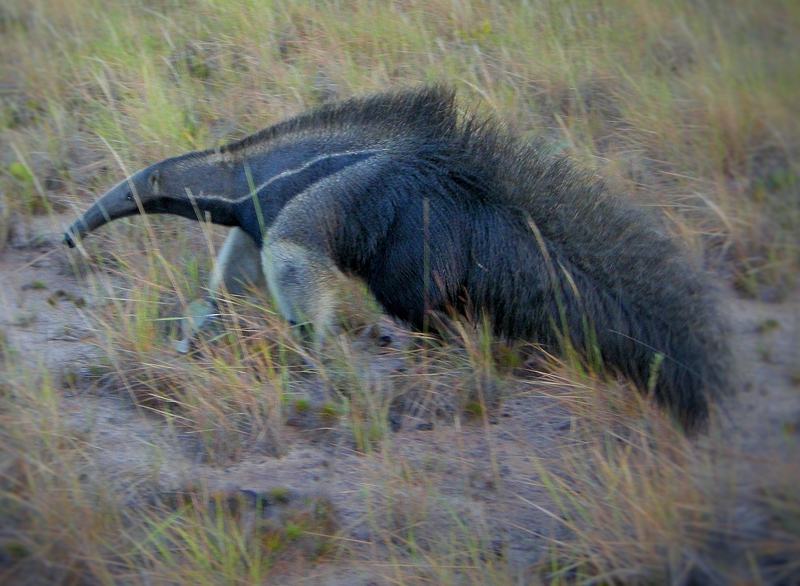
On the last leg home the pilot of the boat steers us safely through narrow channels whilst shining a powerful torch onto the riverbank, the twin reflection of Caiman’s eyes is quite eerie especially as they disappeared below the surface. Your final memorable sighting may be of a family party of Capybara, these huge rodents graze along the riverside in complete darkness totally oblivious of our presence.
This superb outing will indeed, be one of the highlights of the whole tour and is absolutely not to be missed.
On the nearby airstrip, Nacunda, Least and Band-tailed Nighthawks can be seen at dusk together with White-tailed Nightjar. There are many other possible species and we anticipate two enjoyable evenings here drinking the rum punches offered to guests. Only 12 at a time are permitted at Karanambu so we may well be the only very privileged guests.
Day 14
We should have an opportunity for more early morning birding, followed by breakfast, before making our way to the airstrip where we may spot the Sungrebe on the lake near the airstrip, a bit distant though. Our plane will be making a “request stop” for us on its scheduled trip from Lethem to Georgetown. Consequently we cannot request the time, so we shall be leaving at 10.00 a.m. for our flight back to Georgetown.
From Karanambu we go straight to Ogle airport and transfer to Arrowpoint Lodge and Nature Reserve, sadly our last destination before leaving for home. This will be a lovely relaxing end to our trip. We transfer by bus and boat to the lodge in time for lunch.
After lunch we shall go with a local guide to the back of the resort into the Wallaba Forest in search of Mouse-coloured Antshrike and a second chance at Ferruginous-backed Antbird. Other species possible at Arrowpoint include Barred Antshrike, Silvered and Black-throated Antbirds, Thrush-like Antpitta, Plain Xenops, Buff-throated Foliage-gleaner, Ruddy Quail-Dove, Chestnut, Cream-coloured and Ringed Woodpeckers and Painted Tody-flycatcher.
Day 15
A 5.30 start with a pre-breakfast boat trip we shall awake to the sound of Red-shouldered and Red-bellied Macaws. Then we shall take to the Pokorero Creek for a trip to find Crimson Topaz lekking, this little colourful gem is a must-see hummer and a lek is something special as well! Point-tailed Palmcreeper is also a good possibility, this may be seen when we take to the river to see the Crimson Topaz lek.
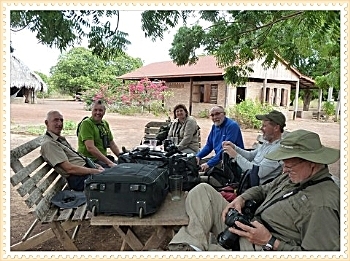
We return for breakfast on the verandah at 8.00. After breakfast we head off along the Toucan trail looking for Manakins, ant birds and hummingbirds. Then there is an opportunity to relax both before and after lunch, possibly in a hammock ! As the birds start to become active again, we can hike through the forest to the White Bellbird calling site. There may then be an opportunity for another boat ride before a bonfire buffet dinner.
Day 16
Our final day has arrived, there should still be time for a little bit of birding before breakfast for the enthusiastic! After breakfast we transfer by boat upriver to Timehri airport, we have use of the executive lounge for a final bit of luxury before boarding our flight to Trinidad and onto London.
WHAT TO EXPECT ON THE TOUR
Some early mornings! Pre-breakfast excursions as well as one or two very early breakfasts (approx 4.30 AM) and one or two picnic breakfasts. This is so that we can be out in the field for dawn, the tropics are far more active at this time, bird song is at its peak at first light..
On several days lunch will be taken at our lodge, followed by a short siesta. Our afternoon birding will take place in the cooler hours when, once again, wildlife become more active.
We have evening boat rides from Karanambu Lodge and perhaps Iwokrama (if time allows).
This tour includes internal air flights, several boat trips, 4*4 excursions and road transfers in the back of a specially adapted 20-seat Bedford truck.
Most birding will be from quiet roads, forest trails, open savannah, boats, the Bedford truck and the canopy walkway at Atta. The trails we walk are mostly flat, easy to moderate, with some steep rocky sections (Turtle Mountain at Iwokrama, Panorama Trail at Rockview) and some trails could be muddy after rains.
You can expect hot weather, at times humid, with a mixture of sun and cloud and occasional rain showers.
Stout, waterproof footwear is essential, a light rain jacket or poncho and a waterproof hat are also recommended. A small umbrella, water-proof bags for cameras etc are also very useful.
Mosquitoes and other biting insects should not be a problem on this tour, but it is advisable to bring insect repellant.
Chiggers are present, gaiters are reccomended as a siutable precaution.
Accommodation vary from simple to modern; all will be comfortable. Our visit to the Macushi village of Surama will be a fascinating experience where we spend one of our nights in a hammock camp!
Most meals are taken at lodges; on some days we have picnic breakfast/lunches prepared for us in order to maximize our time in the field and allow a more flexible schedule. Each evening, after dinner, we discuss the day’s events and sightings, list the birds and other wildlife seen, and prepare for the next day’s itinerary.
Trip Summary
• Diverse wildlife habitats
• Several boat trips on rivers, backwaters & streams
• Both local guides and a Wingspan guide/representative at all times
• Accommodation simple to modern, but all comfortable
• Adapted open-backed truck on transfers with open-backed 4*4 on savannah excursion
• 6 - 10 participants
• Mainly tropical climate, mixture of sun and rain
• Includes three internal flights in small passenger planes
• Trails easy to moderate walking; some steep sections
WHAT'S INCLUDED IN THE TOUR PRICE
- 15 nights accommodation - hotels, lodges, hammock camp (1 night at Surama)
- all meals, with water or soft drinks
- all ground transportation
- 3 internal flights
- several boats trips on rivers
- all entrance fees
- all guiding fees
- checklist of species
NOT INCLUDED
- International Flights
- Drinks except where included as at Rockview and Karanambu where pre-dinner drinks such as rum punches are included!
- Tips and gratuities
- Telephone calls, laundry (unless complimentary at lodges such as Rockview), all purchases of a personal nature
- Travel Insurance
- Excess baggage fees
Latest Trip Reports
-
GUYANA - 2015 - LOST LAND OF THE JAGUAR : Monday, January 23, 0002 - Saturday, February 7, 2015
The best trip I have ever been on,Gill.A truly amazing experience that I will never forget,David.Outstanding natural beauty and some magical wildlife encounters,Les.Read on for an account of a trip of a lifetime in a true wilderness...
View Report
